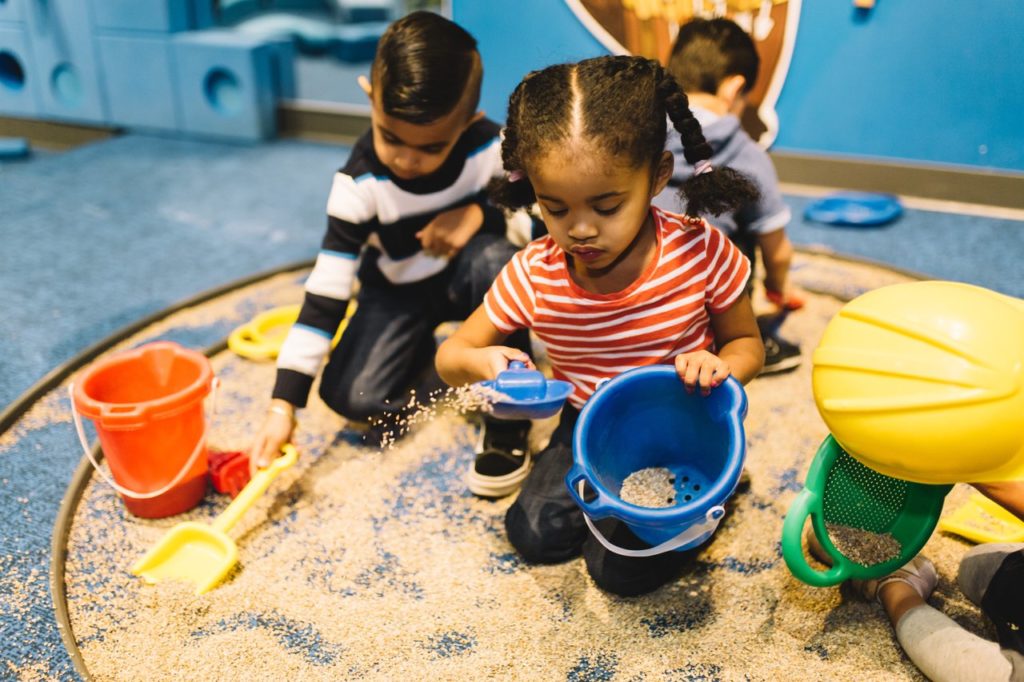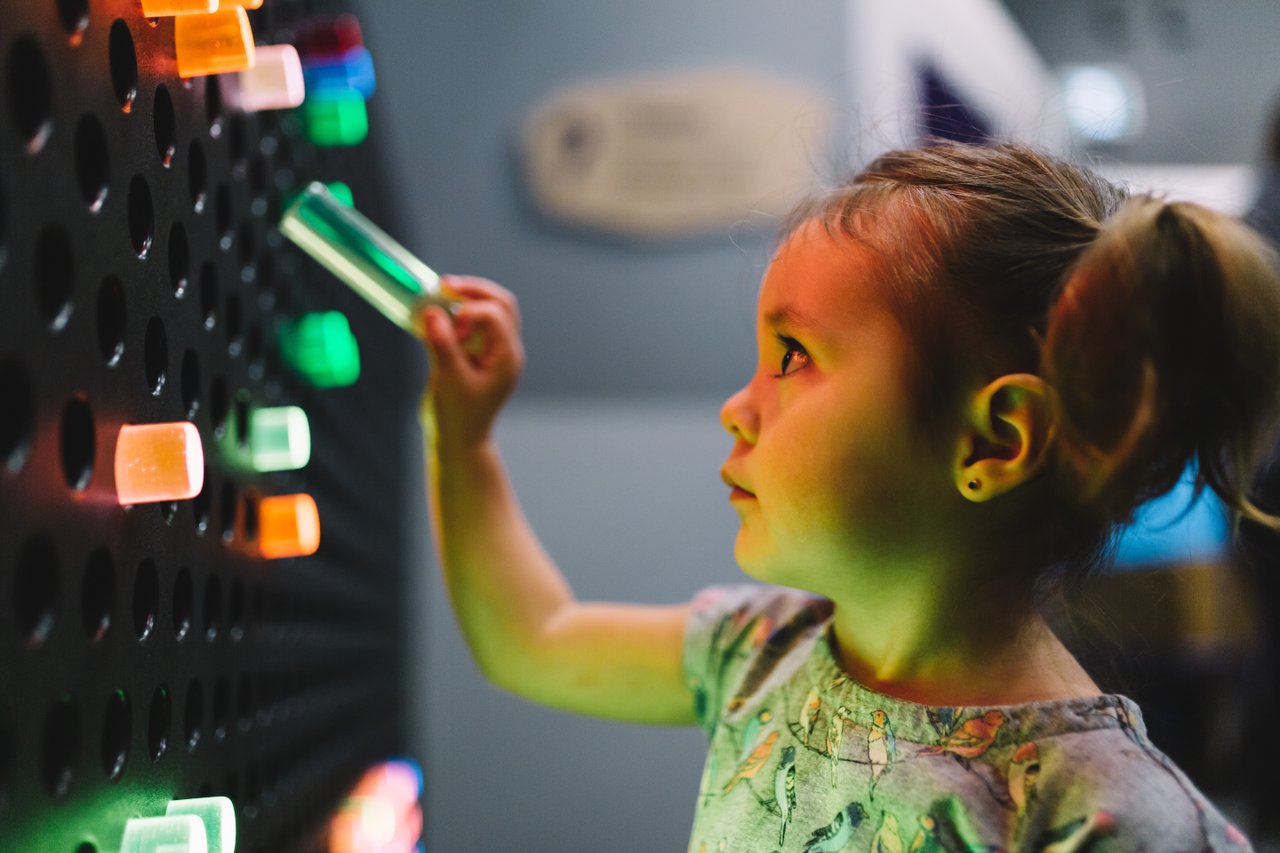Experiment focuses on exploring ideas through hands-on investigations, something both young children and scientists do. In this area, a variety of experiences are regularly changed so children have a chance to ask questions and test their own theories. Experiment is also an area for us to test new ideas with visitors. By learning more about early childhood learning, we can continually develop more innovative and richer experiences.
When your child is playing in the EXPERIMENT area….
Children and their caregivers can work together on a variety of tabletop activities. Scientists and young children share similar curiosities about the world, and often question what they observe.
What does the research say?
Scientists and young children share similar curiosities about the world, and often question what they observe.
Splash consists of a water tower, a multi-sectional water table, and a large slate wall for “painting” with water.
The water table has all sorts of activities for kids to discover. They can play with buckets, funnels and other materials, build Duplo structures, create pathways with dams and partitions, and experiment with a very cool water bell and water vortex. At the end of the table are movable water jets which children use to hit and fill targets. On the wall beside the tower is a large slate wall where children can ‘paint’ with water.
When your child is playing in the SPLASH area….
As they play with the water jets, children can fill buckets and other targets with a stream of water. They can learn that filling the bucket with water causes it to tip over, and that water has mass and can make objects move.
At the water table, children can use partitions and other building materials to create water channels. Children can explore how different partition arrangements change the direction of moving water, and which arrangements make water move fastest. Children can use DUPLO blocks to create islands, weirs, dams and other structures in the water table. They can learn that water will move around obstacles, change shape to move through narrow openings, and fill in spaces.
At the Slate Wall, children create drawings and images as they paint with water. They can learn that water makes the slate a darker colour, and that the water eventually evaporates, causing their drawings to disappear.
What does the research say?
If the quantity of water in a container is known and the water is poured from one container to another, children as young as 5 are able to understand that differently shaped containers hold the same volume of water. This is called “conservation” of volume.
The more emphasis made to children on the concept of density (how heavy something is for its size), the more easily children are able to predict what will float or sink in water.
Drawing pictures of objects, people, and events requires children to mentally represent the object they wish to draw: they must have a “dual representation” of the picture they’re creating and the object the picture represents.
Shine is all about light and colour. It features a giant coloured light peg wall, a large kaleidoscope where children can create beautiful design using simple objects and an exhibit that lets children build with light.
When your child is playing in the SHINE area….
Playing at the light tables allows children to create colourful shapes and patterns by manipulating objects on a backlit surface. Children can also learn that new colours can be made by stacking coloured filters, and that some objects allow light to pass through, while other objects do not.
What does the research say?
Learning colour terms is a gradual process. Initially, children form temporary meanings for their colour terms before they label them in an adult-like manner. Learning colour categories is in some ways similar to learning about number systems: children build on broad categories or rudimentary values (in number, the values 1 & 2; in colour, the categories red & green) and then continue to learn additional values and colours as they develop.
Learning about colours requires creating categories – groups of objects, events, people, etc., that share a set of properties or characteristics. Small differences in colour can be grouped into the same category. For example, limes and (green) olives can be labeled with the term green, because these shades both fall into the colour category of “green”.
Children begin to understand the concept of reflection – that what they see when they look into a mirror is themselves – starting around 18 months of age.
Designed for 0-18 month olds and their caregivers, Crawl is enclosed by the Crawl Wall, providing a protected space to keep babies in and older children out. The wall also serves as adult seating, allowing eyes on the gallery while staying with the baby. Activities include pressing buttons to hover objects in an air stream, things to spin, and mirrors, with a “dance bar” so babies can delight in their own dancing reflection. Crawl has a soft, washable floor, and furnishings covered with different textures. There’s also a separate area for playing with toys and checking out books.
When your child is playing in the CRAWL area….
The Crawl area features a variety of tactile activities, allowing babies and toddlers to play with materials, objects, and toys in many textures and colours. For example, when playing with the Push Air Activity, they can watch as objects and fabrics rise up in a stream of air. They can learn that certain textures feel and act in different ways, and some even make different kinds of sounds.
Babies and crawlers can explore many soft furnishings and elements in Crawl, such as stairs, ramps, and crawl-throughs. These features encourage gross and fine motor development as infants and toddlers practice navigating the world and engaging in independent movement. For example, when babies and toddlers use the Dance Bar, they can practice standing and walking on their own as they look at their reflection in the mirror.
Colourful objects, activities, and images are placed 50 cm or lower around the Crawl Wall, because this is the average height of a crawling infant’s field-of-view.
What does the research say?
Six-month-old infants are able to distinguish a causal event (pushing this button causes this colourful tube to spin) from a non-causal event, even though the events may occur at the same time.
Infants can successfully reach and grasp stationary objects around 4 or 5 months of age, a time at which they begin to predict the movement patterns and paths of moving objects.
Infants are born with a “stepping reflex”– they instinctively “step” when they are held under their arms and their feet are placed on a solid surface. However, this reflex disappears around two months of age, and doesn’t reappear until infants have developed the strength and muscle mass to walk.
Climb is our tallest exhibit ever and it’s all about climbing and discovering. It’s designed to encourage children ages 3-5 to take healthy risks in a safe environment. For those explorers who make it to the highest platform, they can check out the gallery below through a telescope. A periscope that reaches to the highest platform offers kids at the bottom a view of what’s going on at the top.
When your child is playing in the CLIMB area….
In the suspended steps of the climber, multiple pathways give children the opportunity to practice decision-making and problem-solving, to take safe risks, to engage in physical activity, and to see the gallery from different perspectives.
From the top of the climber, children can see the gallery from different vantage points. Climbing changes children’s visual perspectives of the objects and people below, and using the telescope on the climber allows children to see faraway objects up close and changes their points-of-view.
What does the research say?
Children develop from solving simple problems with 2-step moves (around age 4) to making decisions that require planning 3 or 4 moves ahead (around ages 5 and 6).
Perspective-taking, a form of thinking that requires you to ‘see the world from another person’s point of view’, develops around 3 or 4 years of age. The understanding that another person (in a different location) has a unique point of view is evident in 5-6 year-old children.
Build is the larges area in Wonder. It’s filled with lots and lots of our giant blue blocks, there is a variety of materials to build with, and this area accessible for different ages and abilities. Build is located in a back corner of the gallery, with two walls of blue blocks that enable children to build bigger and more exciting structures by attaching blocks to the wall. On the floor are more of these large blocks, as well as blocks that are half the size, for variety as well as easier handling.
When your child is playing in the BUILD area….
Building with Blue Blocks allows children to create large structures, and to learn that stable and sturdy structures resist gravity and other forces. While building structures of various sizes, children can ‘try out’ different building strategies to see what makes the sturdiest structure. Children can work together or independently as they build, and can engage in imaginative, pretend play as they bring their structures to life.
What does the research say?
Around age 3, children are able to learn and predict the outcome of simple rules, or cause-and-effect relationships: “If I do this, then that will happen.”
By age 2, children begin to grasp the concept of gravity (the force that causes a block to fall to the floor when dropped), but don’t start to understand to the concept of inertia (the tendency for objects in motion to stay in motion) until around 5 or 6 years of age.
By the time children are 5 or 6 years old, they are developing the ability to “mentally rotate,” or spatially represent, an object. They can picture what the object or structure will look like from different perspectives, which is an important skill in building and engineering activities.

